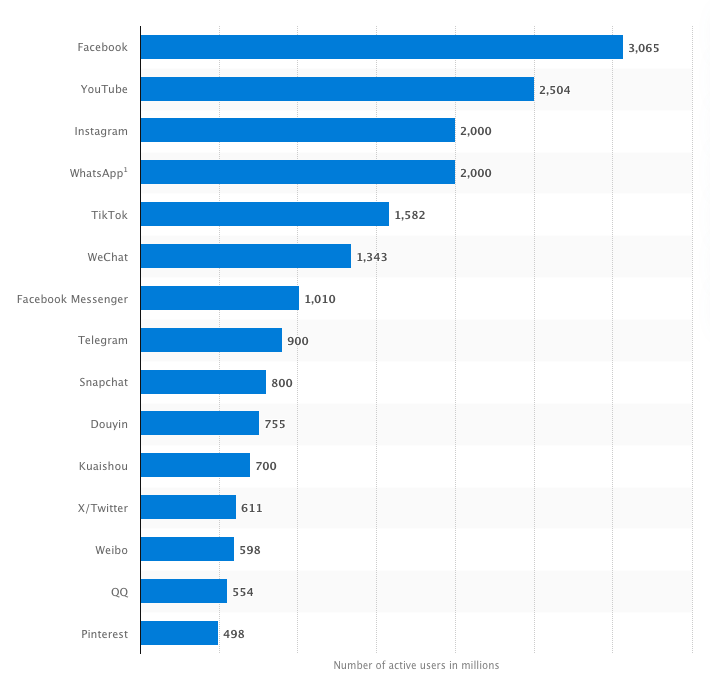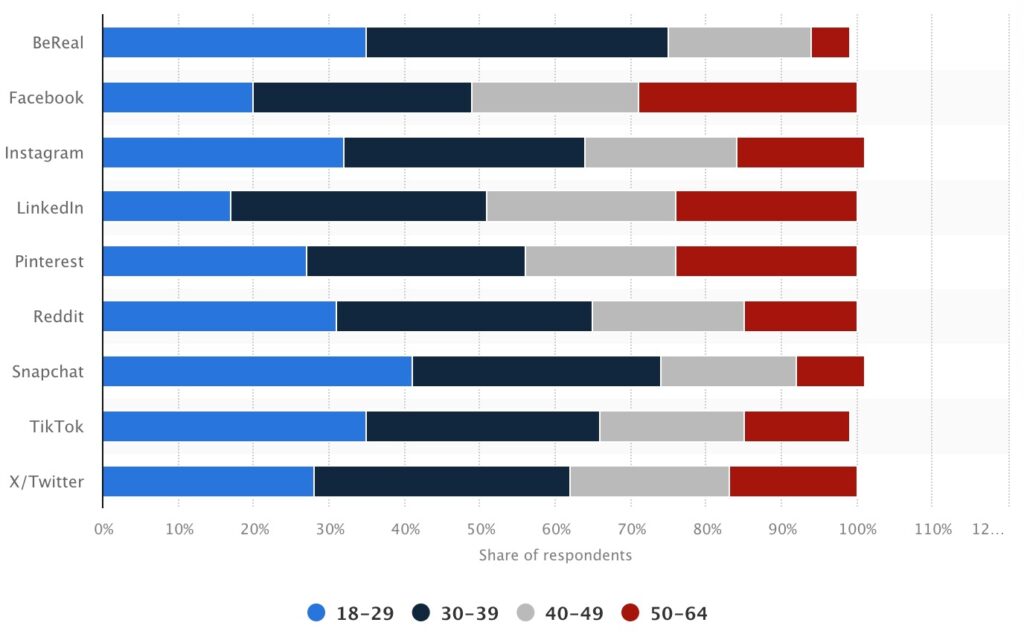Facebook vs. Instagram ads?
Facebook and Instagram ads are both managed through Meta’s advertising platform and share many similarities, but they have distinct differences in terms of audience, ad formats, user behavior, and creative strategies.
So one of the most common questions we get is: “Should I use Facebook or Instagram ads to get better results?”
To find out the answer keep reading!
What are Meta Ads?
Meta ads are paid promotions that show up on various Meta-owned platforms. They help businesses reach people by displaying ads in places where users spend time online.
They’re effective because they reach a large and diverse audience. Meta ads help businesses get noticed, drive sales, and find new customers by placing ads in front of people who are most likely to be interested in what they offer.
Instagram and Facebook ads are both types of ad placements offered by Meta. They are not separate from Meta ads but rather integral parts of Meta’s advertising ecosystem.
Meta manages and integrates advertising across its various platforms, including Facebook, Instagram, Messenger, and the Audience Network.
Here’s how it works:
Facebook Ads: These ads appear on the Facebook platform itself, including in News Feeds, Stories, and the right column on desktop.
Instagram Ads: These ads appear on Instagram, including in users’ Feeds, Stories, Explore, and Reels.
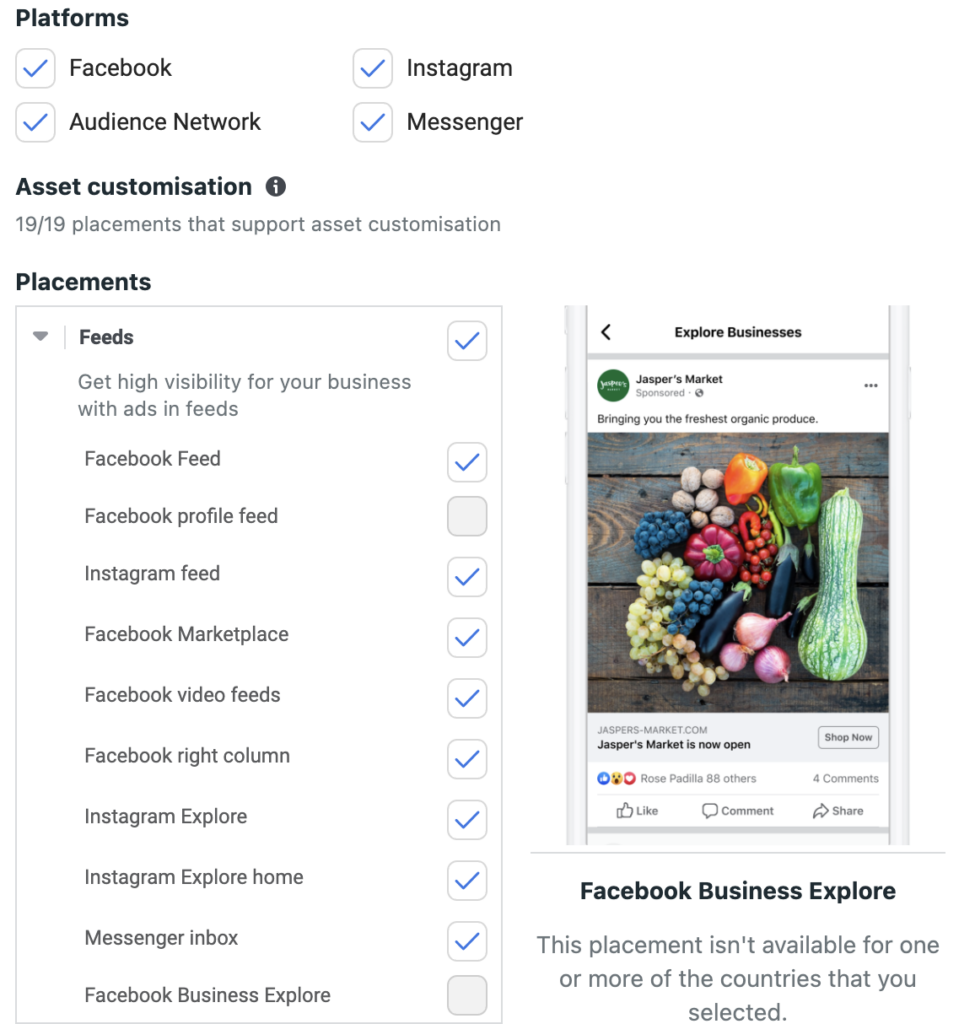
Both platforms are part of Meta’s advertising ecosystem, which allows businesses to manage ads across all these platforms through a single advertising interface. This integration helps businesses reach their target audiences across multiple apps with a cohesive strategy.
Facebook Ads vs. Instagram Ads
Choosing between Facebook and Instagram ads depends on your target audience, advertising goals, and the type of content you want to promote.
The main differences between Facebook ads and Instagram ads lie in their audience, ad formats, user behavior, and how they fit into each platform’s overall experience.
Audience on Facebook vs. on Instagram
Facebook is more diverse in terms of age and usage, making it suitable for a broad range of content and goals. Instagram, on the other hand, is geared towards a younger, visually-focused audience who engage more with image and video-based content.
Generally, Facebook attracts a broader age range, including many users aged 25 to 55+. In contrast, Instagram is popular among a younger audience, primarily those aged 18 to 34.
This difference in user demographics influences behavior on each platform.
Facebook users typically engage with friends and family, stay updated with news, join groups, and interact with a mix of content such as articles, videos, and photos. Meanwhile, Instagram users focus more on visual content, such as photos and videos, with an emphasis on trends, inspiration, and aesthetics. Instagram is often used to discover new styles, follow influencers, and explore lifestyle content.
Ad formats on Facebook and Instagram
The ad formats on Facebook and Instagram are designed to fit the unique experiences of each platform while offering various ways to engage with users. Here’s a comparison of the ad formats available on both platforms:
AD FORMAT
FACEBOOK ADS
INSTAGRAM ADS
Image Ads
Single static images. Ideal for straightforward promotions.
Single, high-quality images in the Feed. Focuses on visual appeal.
Video Ads
Short videos in News Feed, Stories, or as in-stream ads. Ideal for storytelling.
Short videos in Feed or Stories. Great for dynamic content.
Carousel Ads
Multiple images or videos that users can swipe through. Showcases multiple products/features.
Multiple images or videos in the Feed. Useful for showcasing various items.
Slideshow Ads
Video-like ads created from a series of images. Suitable for slower internet connections.
Not commonly used. Instagram focuses more on video and carousel formats.
Collection Ads
Combines images/videos with a full-screen experience. Great for immersive shopping.
Not commonly used. Instagram focuses on Feed, Stories, and shopping features.
Instant Experience Ads
Full-screen, interactive ads that open when clicked. Provides a rich, mobile-optimized experience.
Not available. Instagram focuses on Stories and Reels for immersive experiences.
Lead Ads
Ads with forms to collect user information directly within the ad. Useful for lead generation.
Not available. Instagram does not have lead ad formats.
In-Stream Video Ads
Ads that play before or during video content on Facebook. Captures attention in video contexts.
Not available. Instagram does not have in-stream video ads.
Stories Ads
Full-screen ads between user Stories. High-impact visuals.
Full-screen, immersive ads between user Stories. Engaging and visually focused.
Explore Ads
Ads in the Explore tab, where users discover new content. Reach users interested in new topics.
Ads in the Explore tab. Helps reach users exploring new trends and content.
This table shows the different ad types on Facebook and Instagram, highlighting each platform’s strengths and how they fit their users’ experiences.
Placement options on Facebook vs. Instagram ads
Regarding ad placements, Facebook and Instagram ads share some of the same placements, but each platform offers them within its environment. For example, both platforms provide Feed ads, using similar formats like square (1:1) images and vertical (4:5) videos.
However, some placements are exclusive to each platform—like Marketplace ads, which are only available on Facebook.
- Facebook ad placements include Feed, Marketplace, Video Feeds, Right Column, Stories, Reels, In-Stream Videos, and Search Results.
- Instagram ad placements include: Feed, Explore, Home, Stories, Reels, and Search Results.
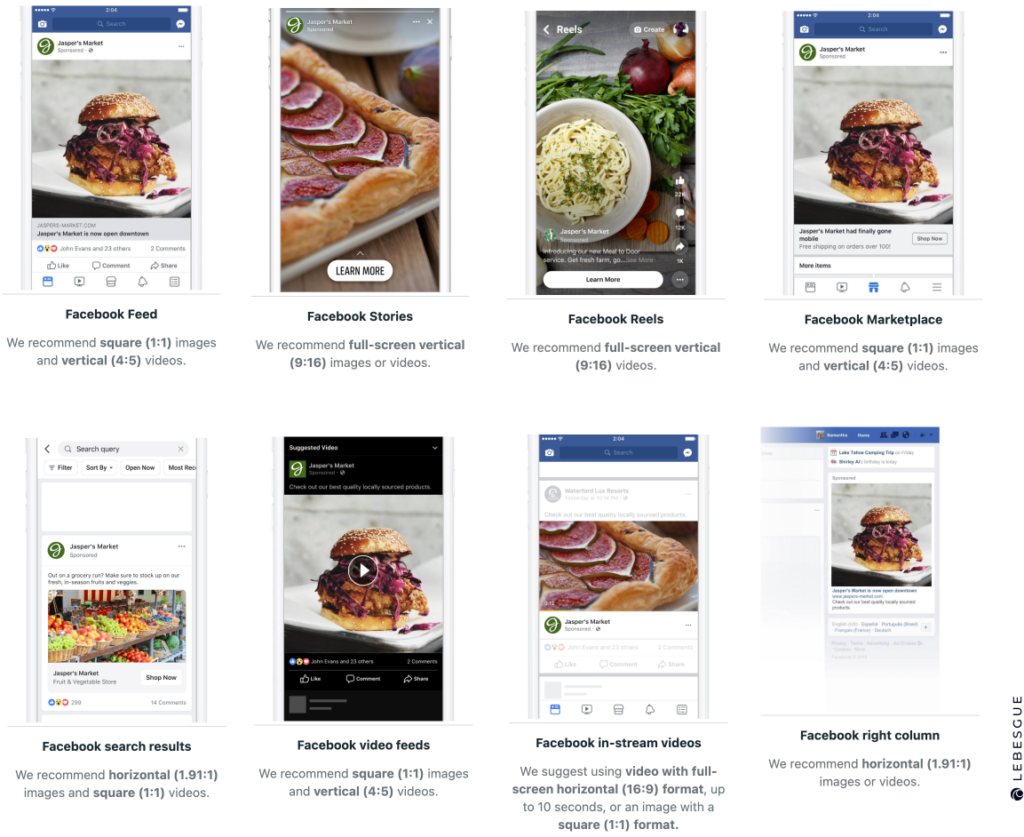
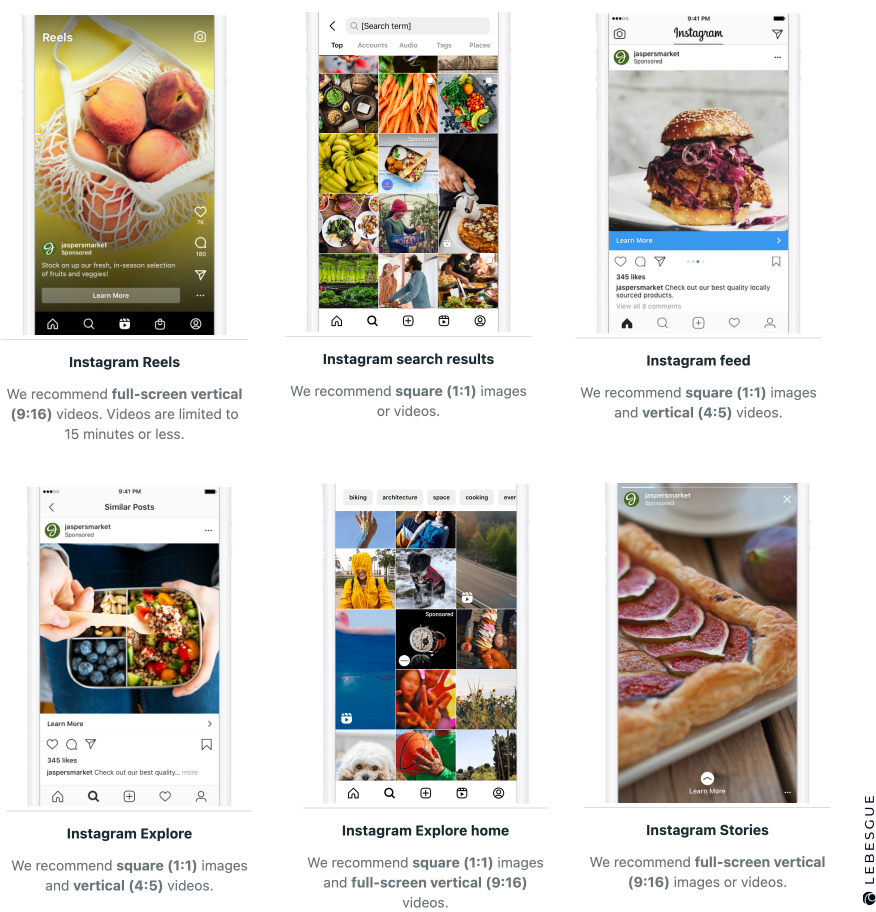
Cost and performance comparison
To truly determine whether Facebook or Instagram ads are better for growing your business, we need to look beyond their features. A deeper analysis of the cost and performance of each platform’s ads is essential to make an informed decision.
When comparing Facebook and Instagram ad performance, each platform has its strengths, and the results can vary depending on factors like audience, creative format, and placement strategy.
So, let’s see the cost and performance comparison of Facebook and Instagram ads.
Ad cost: CPM comparison
Facebook ads often have a higher CPM because the platform offers extensive reach across various user demographics and ad placements. The cost reflects the broad and diverse audience that Facebook can deliver, including news feeds, sidebars, and Marketplace ads.
Instagram generally has a lower CPM compared to Facebook. This is because Instagram’s ad placements focus on visual and story-driven content which tends to be more engaging for younger users. Since Instagram’s audience is highly targeted and engagement is high, advertisers often get a better value for their spend.
So CPM on Facebook ads are between $8 -$12, while on Instagram ads CPM are between $5 – $8.
Advantage+ Placements often provide cost benefits by leveraging Meta’s AI to distribute your budget across the most effective and cost-efficient placements.
Ad cost: CTR comparison
Facebook ads typically have a higher CTR compared to Instagram.
This is because Facebook’s diverse ad placements, including news feeds, video feeds, and Marketplace, engage a broad audience with various interests. The range of ad formats and targeting options often leads to better click rates as ads are shown to users more likely to interact with them.
Instagram usually has a lower CTR. This is due to its focus on highly visual content and the younger demographic, which can be less inclined to click through ads compared to Facebook users.
While Instagram’s visual engagement is high, users may engage more with content passively rather than clicking on ads.
With Facebook ads, you can expect CTR between 1.5% – 2%, and on Instagram ads between 0.8% – 1.5%.
Advantage+ optimizes ad delivery across multiple platforms, ensuring ads appear in contexts where they are more likely to be clicked.
Ad cost: CR comparison
Let’s see what you can expect in the context of CR.
Facebook ads generally have a higher CR due to its extensive targeting options and diverse ad formats. Advertisers can create highly targeted campaigns that reach users who are more likely to convert. The platform’s broad audience and effective retargeting options help drive higher conversion rates.
Instagram typically has a lower CR compared to Facebook. This is because Instagram is more focused on visual engagement and lifestyle content, which might not always drive immediate actions like purchases.
While Instagram users are highly engaged with visual content, their interactions with ads might not always translate into conversions.
The conversion rate for Facebook ads is between 2.5% – 4-5%, and the conversion rate for Instagram ads is between 1.85% – 3.5%.
Advantage+ Placements usually result in higher CRs compared to individual Facebook and Instagram placements
Best Practices for Facebook and Instagram ads: Advantage+ Placements
Advantage+ Placements is Meta’s automated placement strategy that optimizes your ad delivery across all available placements on Facebook, Instagram, Messenger, and Audience Network to achieve the best possible results for your campaign goals.
For the best ad results, we recommend using Advantage+ placements. This option lets Meta’s algorithm automatically optimize where your ads are shown, ensuring they reach the right audience and drive more conversions and purchases.
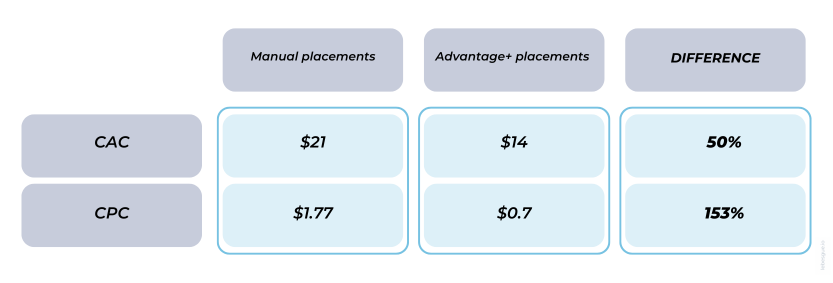
Key insights for Advantage+ placements
Advantage+ Placements tend to have a CPM that is often lower than running separate campaigns on Facebook and Instagram. This is because the automated system places ads where they are most cost-effective, balancing costs between cheaper placements on Facebook and higher-performing ones on Instagram.
Also, Advantage+ generally improves CTR compared to running ads on either platform alone. By automatically adjusting placements, Advantage+ ensures ads appear in contexts that drive more clicks, often outperforming standalone Facebook or Instagram placements.
The combined approach of Advantage+ usually results in higher conversion rates due to optimized delivery. Ads are shown in the most relevant environments across all platforms, maximizing the chances of converting users.
Lastly, Advantage+ placements often reduce CAC by distributing your budget more efficiently.
Since ads are automatically allocated to the placements that yield the best results at the lowest cost, this approach often leads to a more favorable acquisition cost compared to managing placements manually.
Summing up
Let’s sum up this blog post about Facebook vs. Instagram ads. They are both part of Meta’s ad system, with each platform offering unique placements and audience targeting. Facebook generally has a higher CPM and CTR, while Instagram offers lower CPMs but typically lower CTR and CR.
With Advantage+ placements, your ads are optimized for ad delivery across Facebook, Instagram, Messenger, and Audience Network, usually resulting in better overall performance.
Advantage+ typically has a blended CPM, higher CTR, CR, and ROAS compared to individual platform placements.

